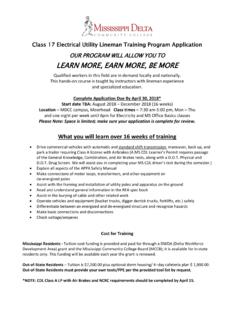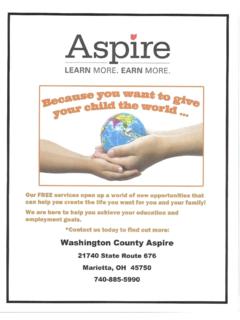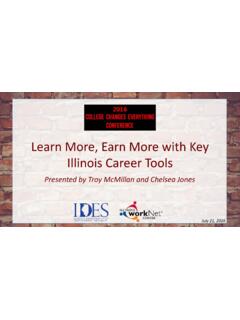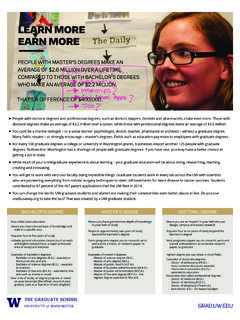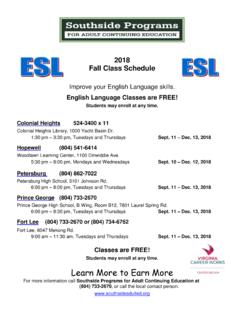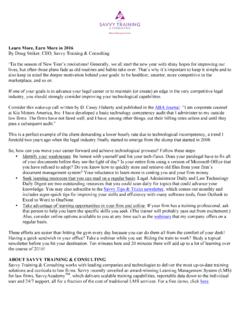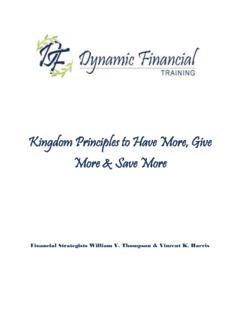Transcription of Learn More to Earn More - Third Way
1 The Economic ProgramE d u c at i o n | F E B Ru aR Y 2 0 1 0 Learn more to earn MoreIn the past, what a person learned in school and picked up on the job was sufficient to carry them through their lives. For one thing, people stayed with the same employer for much longer. But job tenure, particularly among men, is about half the length it used to be. today, moving up often means moving on to a new job. coupled with added pressure from globalization and technology, there is a greater need than ever for adults to continually update their skills and add new credentials. But adult education is often inconvenient, inflexible and H E P R O B L E MGoing back to school for many adults is cumbersome and jobs in the next decade will require a college to the Bureau of Labor Statistics, 57% of jobs in america in 2016 will require education beyond high However, as it stands now, huge segments of the labor force won t be able to meet that requirement.
2 In 2005, 48 million prime-aged american workers about 40% of the workforce had a high school diploma or less. another 20 million workers have completed some post-secondary education but have not earned a two- or four-year Workers without college degrees have more job increased exposure of lower-educated workers to job insecurity is appar-ent in the recent economic downturn. Workers with less formal education have borne the brunt of the ongoing recession. as of January, those with only a high school diploma account for the largest group of the unemployed more than million For workers without college degrees, the unemployment rate is , compared to an unemployment rate of only for individuals with a bachelor s degree or The Progressive Governors InitiativeFebruary 2010 Learn more to earn more - 2 The Economic Program workers are going back to school to earn a degree or refresh their has happened in previous recessions, unemployed workers are most likely to pursue new education or training opportunities when economic times are tough.
3 In fact, community colleges across the country are reporting that enroll-ment is up significantly as a result of the poor economy, with the american as-sociation of community colleges reporting that 2009 calendar year enrollment is already 10% higher than Past recessions have seen similar increases in enrollment, particularly at two-year post-secondary institutions, as the following chart 1988 1989 1990 1991 1992 1993 Enrollment Rate Unemployment Rate Year Enrollment Rate (Millions of Students) at Two-Year Post Secondary Institutions vs. Unemployment Rate (1988-1993) Unemployment Rate Two Year Enrollment Rate But there are many barriers to going back to back to school is often difficult and inconvenient.
4 According to mul-tiple reports and surveys, including reports by the department of Labor and the non-profit Lumina Foundation, prospective students face significant barriers to enrolling in education or training programs. these barriers include inflexible class schedules that don t meet the needs of non-traditional students who juggle work and family obligations, difficult physi-cal access to campuses and learning centers, limited access to child care, and personal reservations adults may have about returning to in addition, cost is a significant factor, especially for workers who have lost their jobs. For example, federal loans are available only to students attending at least half-time, and even though Pell grants are available to less than half-time students, they February 2010 Learn more to earn more - 3 The Economic Program not allow for living expenses or other costs to be counted as part of the cost of Partly as a result, 78% of adult community college students do not complete a two-year degree or program within three years of the solutions we lay out below offer ideas and policy proposals to governors to help adult learners clear the hurdles in their way to going back to school and earning a degree.
5 We propose solutions to make going back to school more affordable and more convenient for mid-career H E S O L U T I O NSReduce the costs for mid-career learnersMid-career students are often most sensitive to cost because they face the pressures of work, looking for work, and providing for a family. We have identi-fied seven ideas that governors can use to reduce the financial burden on adult learners who return to Create a mid-career student loan program for part-time students. current federal policy prevents students enrolled less-than-half-time from accessing Stafford loans to pay for their education, and on a federal level, legislation was introduced in 2007 to allow less-than-half-time students to take out federal on a state level, states could use general revenue to create a loan fund specifically for mid-career individuals in need of further training or education.
6 According to the department of Education s national center for Edu-cation Statistics (ncES), 14% of college students are enrolled less than halftime however, in 2003-2004, of all Pell Grants received, only went to less than half-time students. 2. Implement a Lifelong Learning Account (LiLA) pilot program. Lifelong Learning accounts are portable, employer-matched savings vehi-cles like a 401(k) for continuing education and training. With LiLas, employees are able to save money for future education expenses when looking to move up the ladder. in many instances, employers encourage their employees to save through matching contribution Practices Several states have implemented LiLa pilot programs, including Missouri, Maine, Illinois, Indiana, California, Washington and Hawaii.
7 After the success of these pilot programs in these states, all have had legislation introduced to create LiLas. in addition to these seven states, legislation in Wisconsin has also been introduced. in Illinois, the pilot program was February 2010 Learn more to earn more - 4 The Economic Program additional funding in 2008. Businesses and non-profits in Massachusetts, Michigan, New York and Pennsylvania are currently working to develop LiLa pilot Legislation has also been introduced at the federal level to create national LiLas. in the 110th congress, Senator Maria cantwell (d-Wa) and Senator olympia Snowe (R-ME) introduced the Lifelong Learning accounts act of 2007 (S. 26), and Rep. Rahm Emanuel (d-iL) and Rep.
8 Jim Ramstad (R-Mn) introduced the Lifelong Learning accounts act of 2008 ( 6036).123. Mid-career scholarships for adults wanting to go back to school. nearly all states have grants for young people to attend college, but only a few have scholarship programs aimed at mid-career adults. States could provide state-funded competitive scholarships targeting mid-career workers looking to upgrade their skills and education. Financial assistance for postsecondary educa-tion continues to be focused on traditional students entering after high school, despite the increasing demand for adults to go back to school. Working adult students could apply for these mid-career scholarships, which would provide full or partial tuition payment at state universities and community colleges.
9 Best Practices the Indiana Part-time Grant program was established to assist part-time degree-seeking students who have demonstrated a commitment to pursuing postsecondary education at an indiana public or private college. Students must be enrolled in at least 3 but fewer than 12 credit hours per term, and eligibility is determined at the institutional level. depending on financial need, students can receive up to $4,000 per academic in Georgia, students who are residents of the state and graduated with a high school diploma after 1993 are eligible for the state s HoPE scholar-ships which provide students with tuition assistance to attend Georgia schools. the state allows non-traditional students who graduated high school prior to 1993 to qualify for HoPE grants.
10 Non-traditional students are eligible for HoPE grants if they are pursuing a degree at a technical college, have maintained a cumulative GPa in post-secondary courses they have taken, but not have achieved a bachelor s degree before. the HoPE grant amount is equal to tuition, mandatory fees, and a book allowance of up to $100 per Tuition grants for the unemployed. States could provide tuition allowances to workers receiving unemployment benefits. For example, workers who have been laid off could be given a tuition allowance or waiver for one or two semesters of part-time study or training. this February 2010 Learn more to earn more - 5 The Economic Program would encourage workers to begin the process of earning a degree or certification.
